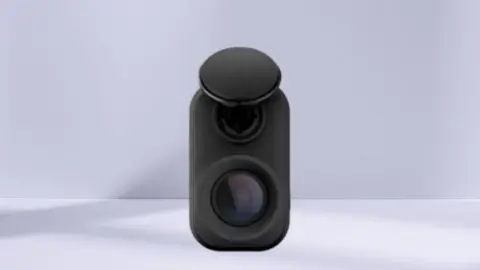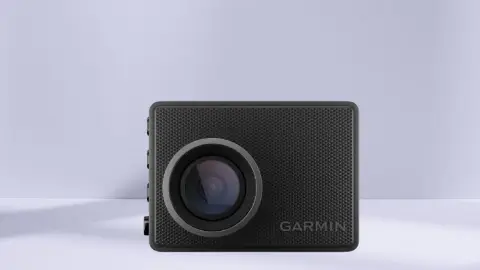Garmin brought a series of mini dash cams to market in the Summer of 2021, and we were excited to get an opportunity to take a look to see how well these little cameras work. Over the years of testing dash cameras, we have complained about the bulky size of many cameras on the market that gives vehicles an undercover cop car look, so we were immediately interested in the Garmin cameras. In this article, we will show you the features of the Garmin Mini 2 vs 47, two of the four new models.
Garmin Dash Cam Mini 2 vs 47 Dash Cam Side by Side:
 |  | |
|---|---|---|
| Garmin Mini 2 | Garmin 47 | |
| Resolution (front) | 1080p HD | 1080P @30fps |
| View angle | 140° | 140° |
| Built-in Wi-Fi | Yes | Yes |
| Built-in GPS | Yes | Yes |
| Parking mode | Yes | Yes |
| Maximum capacity | 256 GB | 256 GB |
| Price | Find on Amazon | Find on Amazon |
Camera and Quality
We love compact dash cams that are discreet and blend into the interior of most cars. Garmin intends the Mini 2 and the 47 cameras to be mounted behind the rearview mirror where the camera is out of the way and hidden from view. As soon as we picked these cameras up, we could tell that the diminutive size was perfect for stashing behind a rearview mirror, but we were concerned about how well they would fit in cars and trucks with bulky rearview mirrors that have built-in sensors.
Our concerns were unfounded, and we easily mounted both cameras, even on windshields with big mirrors. These cameras use a single power cable, making a discreet installation clean and professional. Once installed, we remarked that the cameras largely disappeared. We do not doubt that other companies will take note and introduce similar designs.
Both cameras use identical lens technology to capture video at 1080p HD resolution at 30 frames per second. This is the minimum resolution we would accept in a dash cam. Anything less, and the video image is not high quality enough to be useable in court. Both cameras have a field of view of 140 degrees.
The Garmin Mini 2 simply captures video. It does not try to do anything fancy, and that is fine. Some people just want a dash cam. The Garmin 47 uses the display to offer additional features, including advanced driver safety systems, red light camera warnings, and GPS data. The added features can be valuable to some buyers, but we found that the need to mount the camera below or beside the mirror to use the display created an additional distraction.
Common features between these cameras include voice control, live view (with optional power cable), and parking mode (with optional power cable). We have found that features like voice control are not very useful in practice because it is usually too late to get the desired image once you tell the camera to record.
Best Camera and Quality: Garmin Mini 2
Storage Capacity
The Mini 2 and 47 offer onboard storage using a miniSD card. The package includes a “starter” card rated at 16 GB, and both can accept up to a 512 GB Class-10 card. We recommend picking one up ASAP to get the most out of the cameras. At 16 GB, you’ll get no more than just a few days of video before the card overwrites and you lose the information.
Drivers can opt to use the Garmin Vault which is a cloud-based pay-to-use plan. Garmin provides free 24-hour video in the cloud, but drivers will pay between $5 and $20 monthly for expanded cloud storage. Upgrading the microSD card is the best solution.
Best Storage Capacity: Tie
Battery Life
It is important to remember that the onboard Lithium Ion rechargeable battery is not intended to offer runtime recording. It is there only to ensure that the camera will continue to function following a catastrophic car accident that causes a loss of vehicle power. The battery keeps the camera running for approximately 30 minutes after a major accident cuts vehicle power.
The cameras include a 12v ACC power cord that plugs into a cigarette lighter and offers a USB port for charging your smartphone. To get the most out of these cameras, a hardwire kit is required that Garmin sells separately. We would have liked to have seen this cable included with the package as many competitors offer.
Battery Life: Tie
Garmin Mini 2

Pros
- One of the smallest and most discreet dash cams we have ever tested
- The super-simple operation makes this an ideal camera for people who don’t like to fuss with technology
- The Garmin app offers the potential for extensive upgrades, including linking four cameras for a 360-degree view
Cons
- The added cost of a constant power cable and an SD card for video storage makes the low price deceptive
- The camera tends to disconnect from WiFi during operation and can take as long as two minutes to reconnect
The Mini 2 is one of the smallest dash cams we have seen -a huge plus when you don’t want clutter on your windshield. It does what it needs to do – capturing video of your vehicle’s front. The lack of frills makes it ideal for drivers that don’t like to fuss with technology and want something simple, unobtrusive, and effective.
It lacks a few features we would like to see -most importantly, a GPS antenna for location logging- but the compact size and discreet installation won us over. We were surprised to find that the Mini 2 has live view and parking mode technology -and disappointed to find out that we had to purchase an expensive power cable to make it work. Parking mode can be a huge benefit if you park in places where people vandalize cars, but the forward-only camera does limit the effectiveness of parking mode.
Garmin 47

Pros
- The advanced driver safety system provides a full-screen display of the alert, a much better feature than some cameras
- The overall size is smaller than many other camera designs for a more discreet installation
- The power cable can mount so the cable runs in either direction
Cons
- The resolution on the display screen is terrible
- The biggest draw of the camera is its discreetness, which is ruined by the need to install the camera with the screen visible
- Additional optional components drive up the price substantially
On first impression, the Garmin 47 looks and feels like a superior design to the Mini 2. Once installed, we liked the Mini 2 better for a few reasons. A big reason is the TFT LCD display on the Garmin 47. We have used many dash cams with displays and generally do not like them. The 47 is no exception, and it is actually one of the worst we have seen.
The display offers only a 320×200 resolution which makes viewing videos difficult. The resolution is too poor to see important details like license plate numbers, and we had difficulty reading make and model information on the screen. The biggest issue is that the 47 is designed to mount behind the mirror, which makes the screen impossible to view in the car. The only solution is to mount the camera below or next to the mirror, eliminating the discreetness we like about these small dash cams.
The display does offer some unique features not available on dash cams without a screen. Advanced driver safety systems let this camera provide lane departure warnings, vehicles moving in front of the driver, and collision warnings. We like how the display shows this information over other designs because it fills the screen with a color-coded message. If it were not for the need to mount the camera where it is visible, this feature would add a ton of value. In practice, these systems are not all that effective unless you are one of those drivers that just can’t pay attention when driving. Check related comparison vs. Garmin 57
Conclusion
We thought that the Garmin 47 would be our favorite of these two, but after spending some time playing with both cameras, the Mini 2 simply offers a better value. Since both cameras offer the same resolution, there isn’t any difference in the video quality. Our decision to choose the Mini 2 over the 47 came down to the display on the 47 (>>> Find price on Amazon). The display is counterproductive to providing a discreet dash cam, and we would buy a higher-quality camera with a better resolution before settling for the 47.